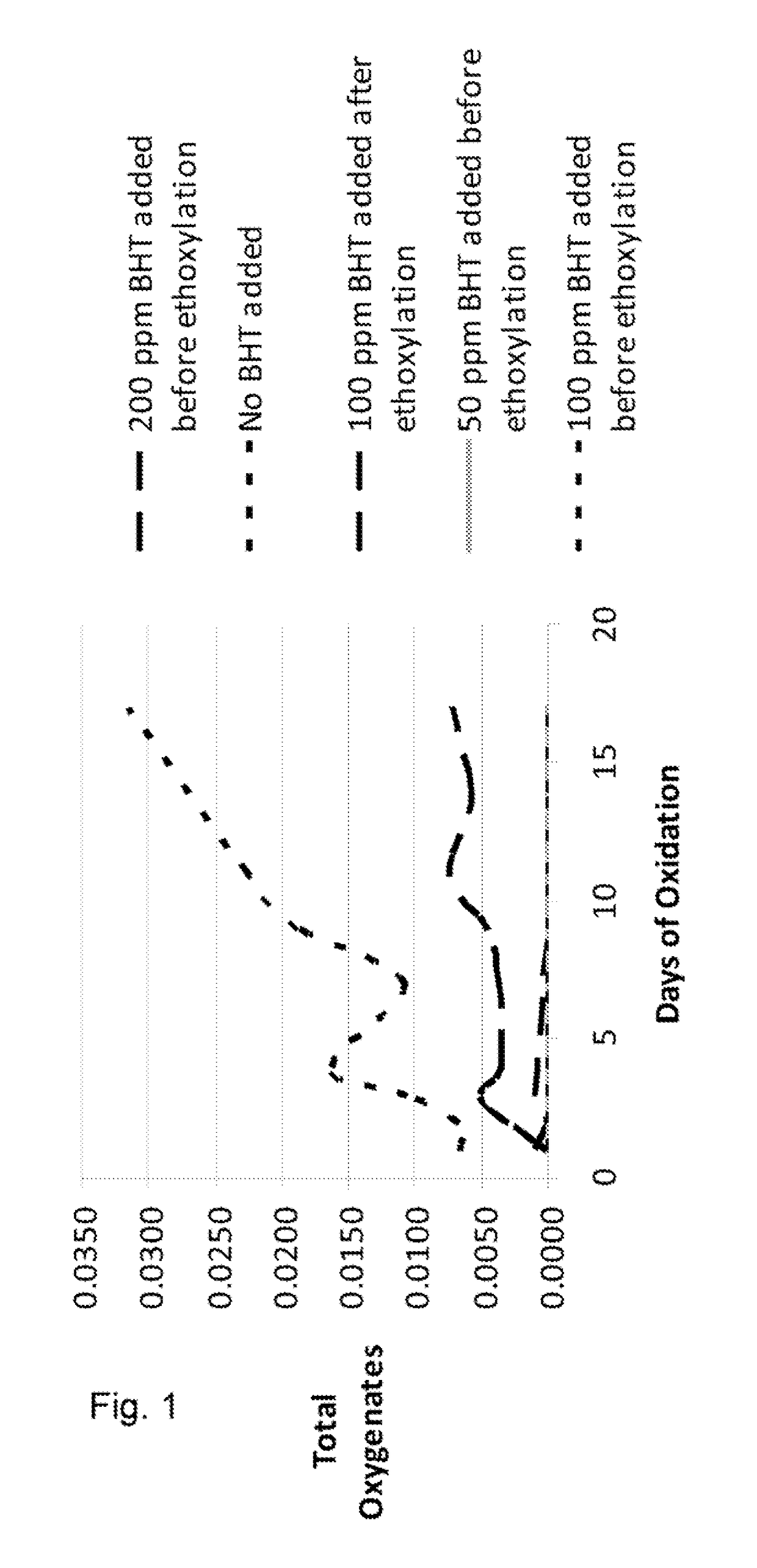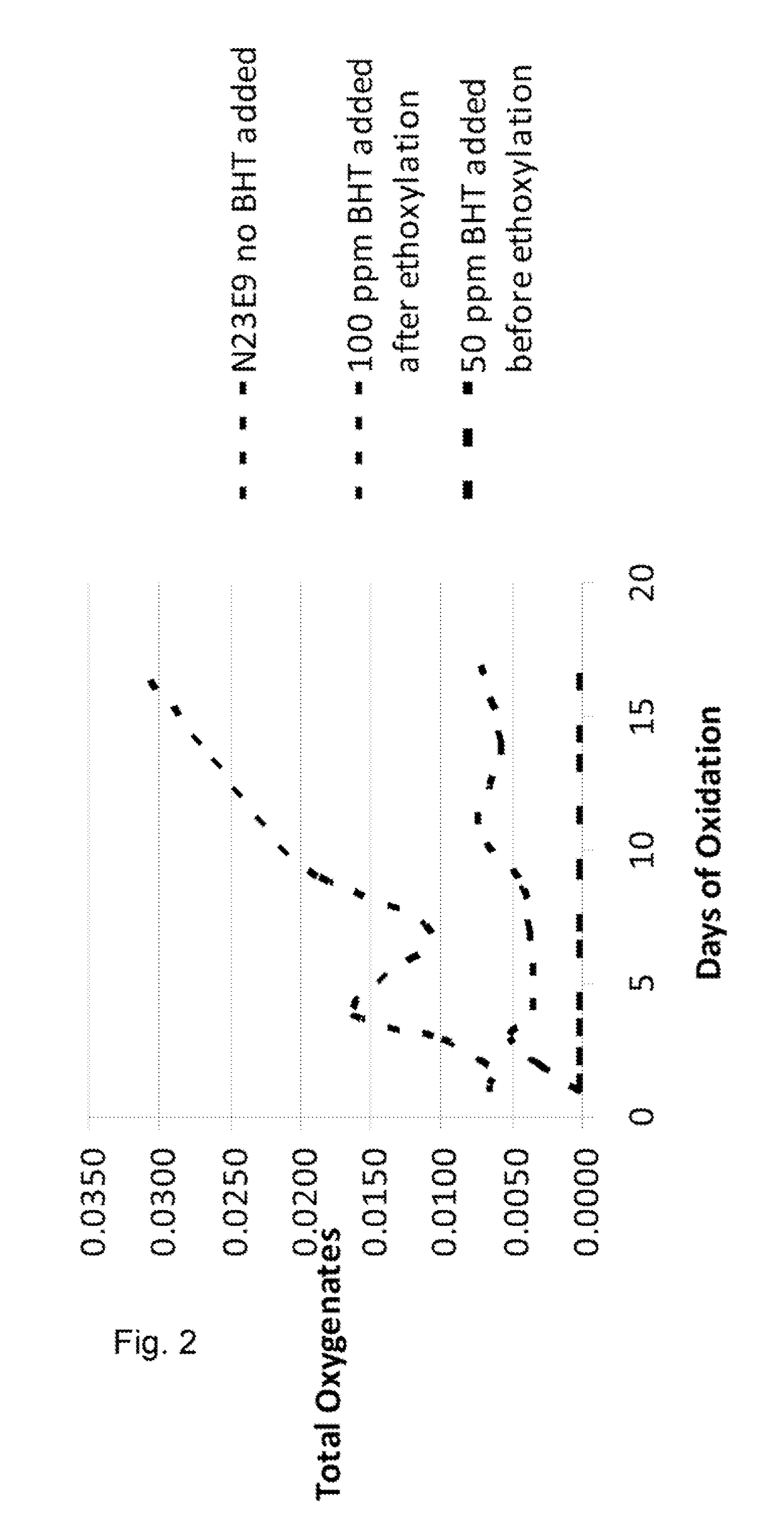Catalyst Compositions, Methods of Preparation Thereof, and Processes for Alkoxylating Alcohols Using Such Catalysts
a technology of catalysts and compositions, applied in the field of alkoxylation catalyst compositions, can solve the problems of difficult to ensure uniform mixing of antioxidant and alcohol alkoxylates within the transportation vessel, and the alkoxylated alcohol is subject to oxidation
- Summary
- Abstract
- Description
- Claims
- Application Information
AI Technical Summary
Benefits of technology
Problems solved by technology
Method used
Image
Examples
example 1
[0037]Samples of a C12-C13 alcohol ethoxylate, having 9 moles of ethylene oxide (EO) were prepared using the catalyst of the present invention. The BHT was added in amounts to deliver 50 ppm, 100 ppm, 200 ppm to the finished ethoxylate. These samples were compared to a sample prepared without BHT and to a sample in which 100 ppm BHT was only added to the finished product. The samples were exposed to air in a forced air oven at a temperature of 60° C. for a period of 17 days. Sample aliquots were taken during this time period and analyzed by NMR for evidence of oxidation by-products including aldehydes, esters, acetals / hemi-acetals, and formate esters. The by-products were reported as “moles per 100 moles of ethoxylate” versus the days of oxidation. The totals of these oxidation by-products were plotted on the Y axis in FIG. 1.
[0038]FIG. 2 shows the same data as that in FIG. 1, but compares only the samples in which no BHT was added, the sample in which 100 ppm was added after ethoxy...
example 2
[0042]Two samples of C6 alcohol ethoxylate having 15 moles of EO were prepared using the catalyst of the present invention. The reaction took place in a reactor with the first sample reacted at 110° C. and the second sample reacted at 130° C. The EO was added for 56 minutes and 74 minutes to the first and second samples, respectively. Thus, the further the temperature was reduced, the faster the EO could be added.
example 3
[0043]Samples of isopentenol having 10 and 50 moles of ethoxylate were prepared using the catalyst of the present invention. The reactions took place at temperatures of 120° C. The amount of catalyst used was 0.2 to 0.4 wt %. FIG. 3 is proton NMR analysis of the isopentenol prior to ethoxylation. FIGS. 4 and 5 are proton NMR analyses of the isopentol ethoxylates having 10 moles and 50 moles, respectively. FIG. 6 shows a proton NMR analysis of the isopentenol ethoxylate with 50 moles of EO made with a prior art sodium methoxide catalyst. Those skilled in the art will recognize that the number of terminal double bonds shown in FIGS. 4 and 5 is the same as in FIG. 3. Thus, the terminal double bonds were preserved during and after the ethoxylation reaction. However, FIG. 6 shows that some of the double bonds have isomerized. In each of the NMR results, for the ethoxylates made with the catalyst of the present invention, the ratio of protons next to the double bonds is consistent that no...
PUM
| Property | Measurement | Unit |
|---|---|---|
| temperature | aaaaa | aaaaa |
| temperature | aaaaa | aaaaa |
| temperature | aaaaa | aaaaa |
Abstract
Description
Claims
Application Information
 Login to View More
Login to View More - R&D
- Intellectual Property
- Life Sciences
- Materials
- Tech Scout
- Unparalleled Data Quality
- Higher Quality Content
- 60% Fewer Hallucinations
Browse by: Latest US Patents, China's latest patents, Technical Efficacy Thesaurus, Application Domain, Technology Topic, Popular Technical Reports.
© 2025 PatSnap. All rights reserved.Legal|Privacy policy|Modern Slavery Act Transparency Statement|Sitemap|About US| Contact US: help@patsnap.com



